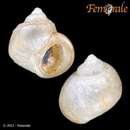en
names in breadcrumbs


Pomatiopsidae ist eine Familie vorwiegend kleiner Süßwasserschnecken aus der Überfamilie Rissooidea. Die Familie umfasst etwa 170 Arten.[1] Einige dieser Arten sind als Zwischenwirte des Pärchenegels, des Erregers der Bilharziose, von Bedeutung.[2]
Die Gehäuse der Pomatiopsidae sind klein, 2,5 bis 9,5 mm lang (z. B. bei Delavaya), dünn- oder dickschalig, oft farblos, durchscheinend oder bedeckt mit einem braunen Periostrakum und wenig ornamentiert. Die Gehäuse mit gewölbten Umgängen variieren in der Form von eiförmig-konisch bis planispiral. Die Gehäuse sind diagnostisch ohne großen Wert. Die Arten der Familie besitzen Kiemen und ein Operculum[3] und sind getrenntgeschlechtlich. Die Kiemen, ein ursprüngliches Merkmal, können aber auch stark rückgebildet sein oder nahezu fehlen. Die Tiere atmen über die Körperoberfläche. Die Reduktion der Kiemen ist nicht beschränkt auf terrestrisch lebende Formen, sondern kommt auch bei rein aquatisch lebenden Arten vor.
Das Sperma dringt in den weiblichen Ovidukt über den spermathekalen Kanal ein, der vom in die Mantelhöhle mündenden Eileiter getrennt ist. Der spermathekale Kanal ist die Verlängerung einer Ausstülpung der Bursa copulatrix. Die Männchen haben einen einfachen Penis, d. h. einen einfachen Leiter ohne Anhänge.
Die Eikapseln sind rundlich und enthalten eine einzige Zygote. Die Oberfläche der Eikapseln ist klebrig; deshalb sind sie von Schlamm und Detritus bedeckt.
Pomatiopsidae sind weltweit in den Tropen und Subtropen verbreitet.[2] Die höchste Vielfalt an Taxa ist in Südost- und Ost-Asien (Thailand bis Japan) anzutreffen. Darüber hinaus gibt es Vertreter in Afrika, Australien, Südamerika und Nordamerika.[4][5]
Nach der Kopulation und internen Befruchtung werden die Eier einzeln im Wasser abgelegt. Die Eier entwickeln sich in der Eihülle zu einer Trochophora-Larve und später zu einer Veliger-Larve. Diese verlässt die Eihülle, so dass die Veliger-Larve die einzige freilebende Larvenform ist. Die Veliger-Larven leben verhältnismäßig lange im Plankton, von dem sie sich auch ernähren. Das Larvalgehäuse entwickelt sich bereits während der planktonischen Lebensphase und vor dem Einsetzen der Metamorphose und dem Übergang zum Bodenleben. Die adulten Vertreter der Pomatiopsidae leben im Süßwasser, amphibisch oder auch auf dem Land. Sie ernähren sich von Algen und Detritus, die sie von der Oberfläche von Steinen, Sediment oder anderen Festgründen abweiden[6].
Das Taxon wurde 1865 von William Stimpson aufgestellt.[7] Es wurde früher meist als Unterfamilie in die Familie Hydrobiidae gestellt. Im zwischen hat sich die Stellung als eigenständige Familie durchgesetzt. Die Familie wird derzeit in zwei Unterfamilien gegliedert, die Pomatiopsinae und die Triculinae[3]:
Taxon mit unbekannter Unterfamilien- und Tribus-Zuordnung:
Pomatiopsidae ist eine Familie vorwiegend kleiner Süßwasserschnecken aus der Überfamilie Rissooidea. Die Familie umfasst etwa 170 Arten. Einige dieser Arten sind als Zwischenwirte des Pärchenegels, des Erregers der Bilharziose, von Bedeutung.
Pomatiopsidae is a family of small, mainly freshwater snails, (some also occur in other habitats) that have gills and an operculum, aquatic gastropod mollusks in the superfamily Truncatelloidea (according to the taxonomy of the Gastropoda by Bouchet & Rocroi, 2005).
Pomatiopsidae are well known as intermediate hosts of Asian schistosomes.[1]
Species in the family Pomatiopsidae occur worldwide.[1] The generic diversity of Pomatiopsinae is particularly high in the Japanese Archipelago, where four of the eight genera, including two endemics, are recorded.[1] The subfamily Triculinae radiated as aquatic snails in freshwater habitats in Southeast Asia.[1]
The American malacologist William Stimpson first defined this taxon as Pomatiopsinae in 1865.[4] Stimpson's diagnosis reads as follows:[4]
Pomatiopsinae, with the shell and operculum as in the Rissoinae. Foot with lateral sinuses. Size small. Amphibious. Genus Pomatiopsis, Tryon.
The family Pomatiopsidae consists of 2 subfamilies (according to the taxonomy of the Gastropoda by Bouchet & Rocroi, 2005)[5] that follows classification by Davis (1979):[6]
Family-group name Rehderiellinae Brandt, 1974[12] is also in Pomatiopsidae, but it is not allocated in detail.[5]
Genera within the family Pomatiopsidae include:
Subfamily Pomatiopsinae
Subfamily Triculinae - there are over 20 genera in Triculinae[1]
tribe Triculuni
tribe Jullieniini
tribe Lacunopsini
tribe Pachydrobiini
Rehderiellinae is not allocated to a subfamily[5]
The Pomatiopsidae have various life habits: aquatic, amphibious, littoral, halophilic, cavernicolous and even terrestrial.[1][13] Terrestrial taxa occur only on the Japanese Archipelago located in East Asia (Blanfordia).[1] Tomichia and Coxiella include several halophilic species occurring on saline lakes.[1]
Pomatiopsidae invaded freshwater habitats from marine ones in one or in two independent lineages.[20] They also invaded terrestrial habitats from freshwater habitats in two independent lineages.[1]
This article incorporates public domain text from the reference[4] and CC-BY-2.0 from the reference[1]
Pomatiopsidae is a family of small, mainly freshwater snails, (some also occur in ) that have gills and an operculum, aquatic gastropod mollusks in the superfamily Truncatelloidea (according to the taxonomy of the Gastropoda by Bouchet & Rocroi, 2005).
Pomatiopsidae are well known as intermediate hosts of Asian schistosomes.
Les Pomatiopsidae forment une famille de mollusques terrestres appartenant à l'ordre des mésogastéropodes ou des Littorinimorpha suivant les classifications.
Selon World Register of Marine Species (22 octobre 2014)[1] :
Les Pomatiopsidae forment une famille de mollusques terrestres appartenant à l'ordre des mésogastéropodes ou des Littorinimorpha suivant les classifications.
Pomatiopsidae is een familie van weekdieren uit de klasse van de Gastropoda (slakken).
Pomatiopsidae is een familie van weekdieren uit de klasse van de Gastropoda (slakken).
Pomatiopsidae là một họ ốc nước ngọt rong liên họ Rissooidea (theo phân loại Động vật chân bụng (Bouchet & Rocroi, 2005)).
Pomatiopsidae là một họ ốc nước ngọt rong liên họ Rissooidea (theo phân loại Động vật chân bụng (Bouchet & Rocroi, 2005)).
盖螺科(學名:Pomatiopsidae)[3],又名圆口螺科[4],是一個科級分類單元,其物種皆為小型、主要為淡水螺(英语:freshwater snail)(也有棲息於其他環境的物種)的有鰓和 口蓋(英语:operculum (gastropod))的淡水生腹足纲软体动物。根據2005年《布歇特和洛克羅伊的腹足類分類)》,本科屬於截螺總科之下[5]。
美國的貝類學家威廉·斯廷普森(英语:William Stimpson)首次在1865年為這個分類單元定義為「蓋螺亞科」(Pomatiopsinae)[1]。 當時斯廷普森的分析如下[1]:
“Pomatiopsinae, with the shell and operculum(英语:operculum (gastropod)) as in the Rissoinae. Foot with lateral sinuses. Size small. Amphibious. Genus Pomatiopsis(英语:Pomatiopsis), Tryon.
” “蓋螺亞科,螺殼及口蓋與麂眼螺亞科物種相同。腹足有橫向側竇。體小。水陸兩棲。
下領一屬 蓋螺屬(英语:Pomatiopsis)(Pomatiopsis Tryon)。
”根據2005年《布歇特和洛克羅伊的腹足類分類》,本科包括兩個亞科[5],與Davis (1979)[7]提的分類相同,即如下:
Family-group nameRehderiellinae Brandt, 1974[13] is also in Pomatiopsidae, but it is not allocated in detail.[5]。這組分類單元在2017年《布歇特等人的腹足類分類》被劃歸截螺總科的Iravadiidae科[14]。
本科之下所包括的屬如下:
本科物種有世界性的分佈[6]。 然而,在生物多樣性方面,本科物種在日本列島的多樣性特別高,八個物種裡有四個物種有分佈,當中更有兩個物種是當地原生種[6]。 擬釘螺亞科物種在东南亚以淡水螺的形式輻射分佈[6]。
盖螺科物種的棲息地呈多樣性:有淡水生的、兩棲的、沿海的(英语:littoral)、嗜鹽的(英语:halophilic)、穴居的(英语:Stygofauna)、甚至陸生的[6][22]也有。不過陸生類群僅在位於東亞日本列島的Blanfordia(英语:Blanfordia)屬物種[6]。Tomichia(英语:Tomichia)屬和Coxiella(英语:Coxiella (gastropod))屬包括多個在鹹水湖棲息的嗜鹽物種[6]。
盖螺科以一到兩條不同的演化路徑(英语:Lineage (evolution))從海路進侵淡水棲息地[2];另外還有以兩條不同的演化路徑進侵陸地棲息[6]。下表綜合本科各屬的棲息環境:
蓋螺科各屬之生物多樣性及棲地總覽 屬學名 中文名 物種數 棲息地 Blanfordia(英语:Blanfordia) 3[6] 陸地[6] Cecina (gastropod)(英语:Cecina) 8[24] 沿岸海邊(英语:littoral)[24] Coxiella(英语:Coxiella (gastropod)) 10[7] (one of them extinct)[7] 鹹水湖[25] Fukuia(英语:Fukuia) 3[6] 陸地和淡水,也有兩棲,often arboreal[6] "Fukuia" ooyagii(英语:Fukuia ooyagii):This article incorporates public domain text from the reference[1] and CC-BY-2.0 from the reference[6]
盖螺科(學名:Pomatiopsidae),又名圆口螺科,是一個科級分類單元,其物種皆為小型、主要為淡水螺(英语:freshwater snail)(也有棲息於其他環境的物種)的有鰓和 口蓋(英语:operculum (gastropod))的淡水生腹足纲软体动物。根據2005年《布歇特和洛克羅伊的腹足類分類)》,本科屬於截螺總科之下。